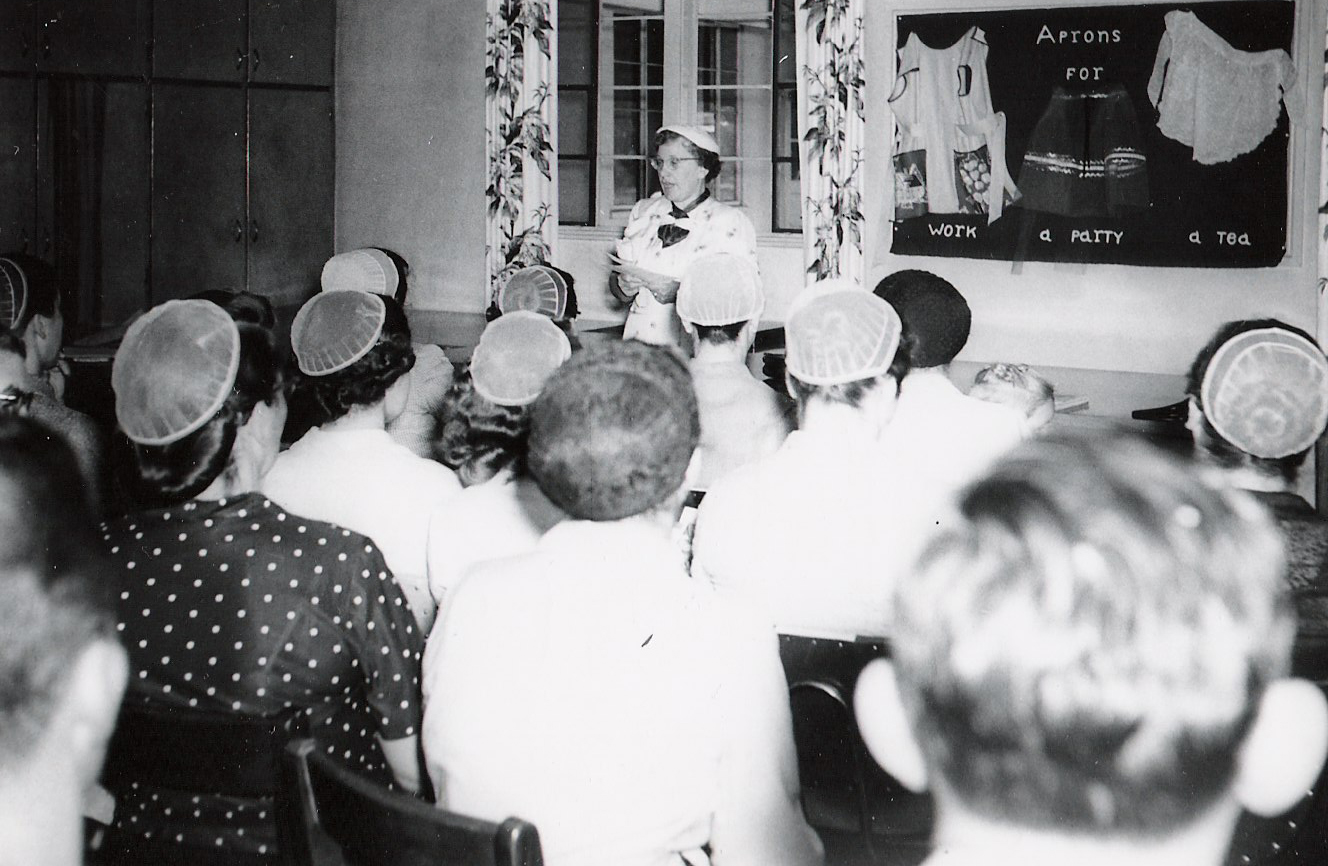
I wish I knew exactly what kind of talk was being given in today’s Photo Friday installment, a snapshot taken during the 1955 General Conference held at Upland College in California. Judging from the billboard on the back wall and the fact that most (if not all) of the audience members appear to be female, I assume it’s some kind of talk on homemaking or housewares. “Aprons for . . . Work . . . A Party . . . A Tea”!
Readers, if you have any insights or other information, feel free to share in the Comments!
Do you think that this seminar took place during the delegate meeting? At this point in denominational history, only men were appointed as General Conference delegates, so it stands to reason that the answer to the question is, “yes.” Perhaps delegate wives and daughters attended these kinds of seminars during the business meetings.
Regardless, I find this picture quite interesting. I think it serves to show how acculturated the postwar Brethren in Christ had become. If you take away the coverings, you’ve basically got a snapshot right out of Good Housekeeping or Ladies’ Home Journal — two of America’s most popular magazines in the 1950s and 1960s!
Personally, I’m intrigued by the diversity of head coverings seen in this picture. The woman at the front, for instance, seems to be wearing a hat rather than a traditional prayer veiling. Additionally, many women appear to be wearing variations on the white mesh covering, while at least one woman wears the more traditional black bonnet.
The variety of coverings worn by Brethren in Christ women is one topic I hope to explore in my master’s thesis, “Born-Again Brethren: The Brethren in Christ, the New Evangelicals, and the Cultural Transformation of a ‘Plain People.'” In my preliminary research, I’ve begun to see that Brethren in Christ women in the 1950s and 1960s began to turn to bible commentaries and other such guides — rather than the traditional authorities within the church — to determine their stance on the prayer veiling issue. These investigations naturally affected the kind of prayer veiling these women chose to wear: some stuck with the traditional black bonnet, some donned the white mesh covering, some chose hats over more formal “coverings” or “prayer veilings,” and some opted for small, unobtrusive cloth squares that could easily be folded up and placed away when not needed in public worship. In taking such individualist (rather than communal) approaches to the issue of the covering, these women revealed the extent to which individualistic evangelicalism had begun to impact their religious thinking and practice. And in determining on their own the size, shape, and material of the covering, these same women defied years of communal tradition. Hopefully I’ll be able to blog more about this topic in the future.

I’m fascinated by this photo, given that it was taken during the 1955 General Conference in California. As it happens, that was the first North American BIC General Conference I ever attended, at the age of 7, while my family was on furlough from missionary service in Africa and we were living in Upland, CA. Interestingly, it was also the occasion of my first confession of Christian faith in a children’s meeting at conference. Unfortunately, I can’t answer your questions, Devin, although it’s quite possible my mother was somewhere in that audience!
A fascinating photo indeed! I have a collection of old aprons from plain to very fancy. (Some culled from used clothing sales at Messiah Village.)
I know that there used to be meetings for women’s prayer fellowship (or something like that) during conference sessions. They were attended by wives of delegates as you surmised. In fact, I attended one when I was in my 20s. I didn’t, however, know that there were ever secular topics presented such as aprons!
An aside–much of what I know of the social history of aprons comes from the book, Aprons: Icons of the American Home by Joyce Cheney. One anecdote I recall is that one farmer’s wife described wearing two aprons at once. The top one to be soiled & removed when someone came to the door. I.e., women didn’t necessarily remove their aprons when guests came to the door. In fact, I have several “fancy” aprons that were made to be worn when guests came for dinner. Another aside: there has been a resurgence of retro aprons. For decades, only plain chef aprons were found in the stores. I now see many replicas of 50s-style aprons on display!
I look forward to your research on head coverings.
Very interesting. Harriet, I had my public confession of Christ at a children’s meeting at a
conference in Kansas. Also, we have a picture taken at a children’s meeting in Ohio where
our speaker let us all dress in costumes from other countries.l
I had thought that women’s meetings would have been like a mission talk or something. But one
of my sisters says that they were about anything the women were interested in. She said
the ladies attended the business meetings as well.
I think that could have been held in an Upland Academy or College sewing classroom with a
leftover display. The windows look familiar. (What curtains!) However, it could have been a conference meeting on that topic. Interesting about vintage aprons.
I just wrote Devin a private e-mail about dress changes in the 50’s as I lived through them. It
was much too long for this blog. Did you have that experience or are you younger? I’d be interested in hearing about others’ memories.